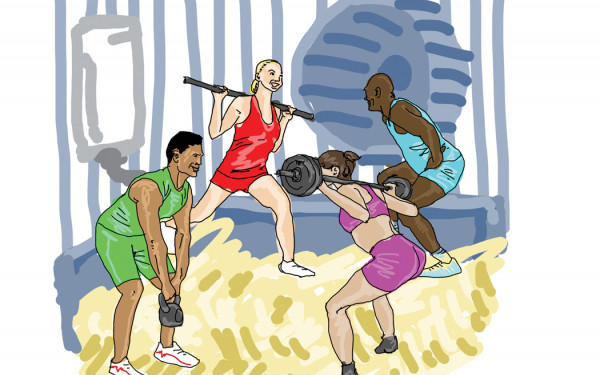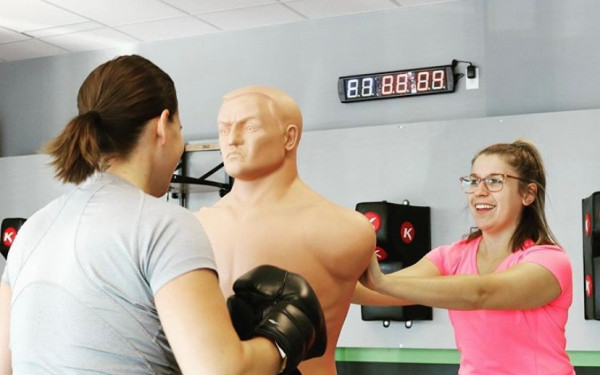Is CrossFit for Concordia?
A Deeper Look Into the Workout Routine’s Used in Montreal
Some think CrossFit could be a way to get Concordia’s student athletes to the next level of performance, while others think it’s an invitation to injury.
n 2001, CrossFit founder Greg Glassman, known simply as “Coach” to his disciples, adopted a new definition of fitness that includes 10 categories: cardiovascular and respiratory endurance, stamina, strength, flexibility, power, speed, coordination, agility, balance and accuracy.
Glassman developed a program to increase an individual’s work capacity across the 10 categories in order to facilitate the performance of all physical tasks.
“[It’s] a strength and conditioning program based on high-intensity and functional movements to get in shape,” said Simon Belzile, an instructor at the Abattoir, a CrossFit affiliate located in the Plateau.
The “Workout of the Day”, or WOD in CrossFit lingo, is freely available online. This approach created a global online community where people discuss and compare results.
CrossFit has grown to include over 1,500 affiliates, including nine in the Montreal area. L’Abattoir counts some 90 members.
The training involved is not about building bigger muscles or looking good—you won’t find a mirror in a CrossFit gym. According to Belzile, “[CrossFit is meant] to [help] prepare for life.”
Workouts are built around highly-functional exercises to stimulate as many muscle groups as possible. Some movements are based on traditional Olympic lifts involving barbells, while others simply use body weight as resistance.
The workouts consist in circuit training and have two basic structures: perform the prescribed number of repetitions of each exercise in the circuit as quickly as possible, or as many times as possible, within the given time.
Aside from low-tech fitness equipment and one’s own body weight, all that is required is a timer and a whiteboard to record the results.
Performance is a matter of public record. This method allows people to compete for the best times and bragging rights.
“In CrossFit, it’s always a competitive setting,” said Belzile, who believes CrossFit’s competitive dynamic may allow ordinary people to feel like, and perhaps become, elite professional athletes.
Some people, notably members of the National Strength and Conditioning Association—a long-standing exercise authority, criticize CrossFit’s “cavalier” attitude towards technique and injury. Critics point to the potential for a variety of injuries.
“I’ve applied most of their stuff and it works,” said Joel Forbes about the NSCA. Forbes is a personal trainer at Concordia’s Le Gym.
“When you deal with complex movements like that and you do them excessively, there’s a huge risk of injury,” he said.
Evan Ross, a Concordia graduate and a former student athletic therapist for the Stingers’ football team, thinks CrossFit has potential, but is also concerned that it might be dangerous.
“It’s not for everyone. The fact that it’s on a website is dangerous for newbies. People need supervision to do that kind of stuff safely,” said Ross. “It is the next step. People are finding an outlet to be creative with exercise. It is one of the highest levels of fitness training out there.”
Ross currently works as a personal trainer and studies osteopathy. He believes that, for many, the risks outweigh the benefits. But for a select few, like the Concordia Stingers, the rewards are obvious.
“For a high-level athlete, that’s the kind of training they should be doing,” said Ross.
Some contend that CrossFit’s generalist approach is not well suited to the highly-specialized needs of athletes.
“You really have to concentrate on one thing at a time,” said Forbes.
Some see CrossFit as a sport in its own right.
“Like in any sport, there’s a risk of injury. There are many more injuries playing hockey or just running,” said Belzile. “For some of us it’s a sport, [and] when I present CrossFit to people, I like to present it as a sport.”
Many people feel the same way as Belzile. In 2007, the inaugural CrossFit Games were held to provide “The ultimate proving grounds of the world’s fittest athletes.” It brought together elite crossfitters to compete for cash prizes.
The annual event has grown in size and scale. The Games are limited to a small number of participants, with 13 regional qualifiers held around the world to select the 2010 finalists.
Starting to fill a competitive void between qualifiers and finals for crossfitters in Quebec, the first ever CrossFit circuit du Québec will take place Oct. 23 at CrossFit Montréal at 4850 Saint-Ambroise St.
This article originally appeared in Volume 31, Issue 09, published October 12, 2010.

__726_700_90.jpg)
__687_700_90.jpg)
_1_700_815_90.jpg)
_600_832_s.png)



